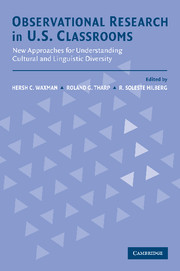 Observational Research in U.S. Classrooms
Observational Research in U.S. Classrooms Book contents
- Frontmatter
- Contents
- Tables, Figures, and Appendixes
- Contributors
- 1 Introduction: Purposes and Perspectives on Classroom Observation Research
- 2 Using Multiple Perspectives in Observations of Diverse Classrooms: The Sheltered Instruction Observation Protocol (SIPO)
- 3 The Standards Performance Continuum: A Performance-Based Measure of the Standards for Effective Pedagogy
- 4 The Uses of the Classroom Observation Schedule to Improve Classroom Instruction
- 5 Development and Use of a Classroom Observation Instrument to Investigate Teaching for Meaning in Diverse Classrooms
- 6 Patterns of Language Arts Instructional Activity and Excellence in First– and Fourth–Grade Culturally and Linguistically Diverse Classrooms
- 7 Using Classroom Observation as a Research and Formative Evaluation Tool in Educational Reform: The School Observation Measure
- 8 Observing School Restructuring in Multilingual, Multicultural Classrooms: Balancing Ethnographic and Evaluative Approaches
- 9 Sociocultural Activity Settings in the Classroom: A Study of a Classroom Observation System
- 10 The Influence of School Reform on Classroom Instruction in Diverse Schools: Findings from an Observational Study of Success for All
- 11 Future Directions for Classroom Observation Research
- Index
- References
7 - Using Classroom Observation as a Research and Formative Evaluation Tool in Educational Reform: The School Observation Measure
Published online by Cambridge University Press: 23 November 2009
- Frontmatter
- Contents
- Tables, Figures, and Appendixes
- Contributors
- 1 Introduction: Purposes and Perspectives on Classroom Observation Research
- 2 Using Multiple Perspectives in Observations of Diverse Classrooms: The Sheltered Instruction Observation Protocol (SIPO)
- 3 The Standards Performance Continuum: A Performance-Based Measure of the Standards for Effective Pedagogy
- 4 The Uses of the Classroom Observation Schedule to Improve Classroom Instruction
- 5 Development and Use of a Classroom Observation Instrument to Investigate Teaching for Meaning in Diverse Classrooms
- 6 Patterns of Language Arts Instructional Activity and Excellence in First– and Fourth–Grade Culturally and Linguistically Diverse Classrooms
- 7 Using Classroom Observation as a Research and Formative Evaluation Tool in Educational Reform: The School Observation Measure
- 8 Observing School Restructuring in Multilingual, Multicultural Classrooms: Balancing Ethnographic and Evaluative Approaches
- 9 Sociocultural Activity Settings in the Classroom: A Study of a Classroom Observation System
- 10 The Influence of School Reform on Classroom Instruction in Diverse Schools: Findings from an Observational Study of Success for All
- 11 Future Directions for Classroom Observation Research
- Index
- References
Summary
Through the Comprehensive School Reform Demonstration (CSRD) program (Public Law 105–78; see Doherty, 2000) and Title I School-Wide programs (Natriello & McDill, 1999), there is currently considerable impetus for reforming education using whole-school change models. Implementing comprehensive school reform (CSR) programs requires tremendous commitment and effort by school districts and their individual schools. As the literature on school reform indicates, it also takes time (Bodilly, 1996). What the public, media, and school boards sometimes fail to understand is that programs by themselves are not what improve student learning. Rather, the critical factor is the positive changes that the reforms engender in school climate, resources, and, most critically, the quality of classroom teaching and learning. But whether achievement effects are evidenced in a relatively short period, as occurred after 2 years in Memphis (Ross et al., 2001) or, more typically, after 5 or more years (Herman & Stringfield, 1995; Levin, 1993), key stakeholders (e.g., the public and school boards) want fairly immediate information about what is happening in the schools to justify the reform effort. At the same time, teachers and administrators within schools need formative evaluation data to know whether their efforts are producing the tangible changes desired.
These considerations prompted our development of the School Observation Measure (SOM; Ross, Smith, & Alberg, 1999), the instrument to be described in this chapter.
- Type
- Chapter
- Information
- Observational Research in U.S. ClassroomsNew Approaches for Understanding Cultural and Linguistic Diversity, pp. 144 - 173Publisher: Cambridge University PressPrint publication year: 2004
References
- 23
- Cited by


